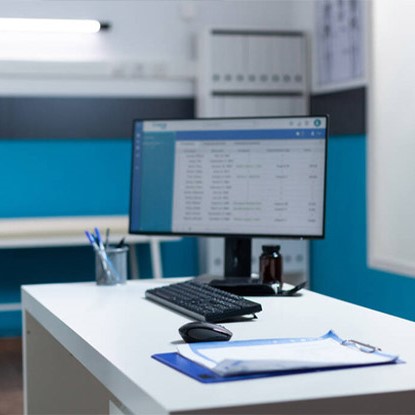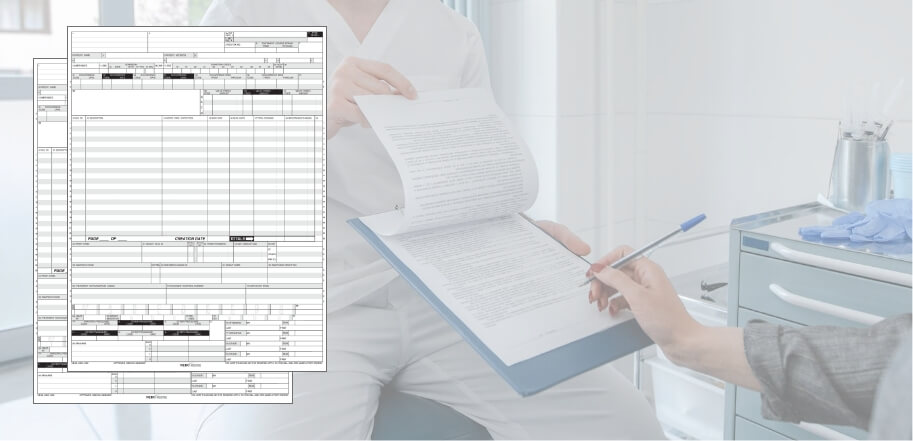OCR Capture in Healthcare Billing: Streamlining UB-04 Form Processing


For healthcare institutions, billing and coding can be a complicated and time-consuming process. The UB-04 forms, in particular, provide essential details for reimbursement, but their manual processing can prove to be a daunting task.
Fortunately, there is a solution that can help healthcare providers streamline their billing and coding process while reducing errors and increasing efficiency. Optical Character Recognition (OCR) technology can offer an automated means to capture and process billing information with ease. Keep reading to learn how OCR can help streamline healthcare billing and simplify UB-04 Form processing.
But first things first, what problems are healthcare billing professionals trying to resolve?

OCR technology is making the healthcare billing process simpler and more efficient. It not only provides speed and accuracy to the process but also reduces the number of errors. Try Artsyl ClaimAction today and elevate your healthcare billing to new heights!
Healthcare billing involves a complex process with various challenges that healthcare providers and billing departments must navigate. Some common challenges of healthcare billing include:

Addressing these challenges requires efficient billing processes, well-trained staff, advanced billing software, and effective communication between healthcare providers, billing departments, and insurance companies. Staying proactive, keeping up with industry changes, and implementing best practices are essential for successful healthcare billing operations.
Tired of the hassle and errors in manual UB-04 form processing? Let Artsyl ClaimAction do the heavy lifting for you. Our cutting-edge OCR technology ensures precise data extraction, faster claims processing, and seamless integration with your systems.
Book a demo now
The healthcare industry may be hesitant to adopt new technology, but recent advancements in OCR (optical character recognition) technology have drastically improved healthcare billing processes.
OCR technology automates the tedious task of manual data entry for healthcare claims and drastically reduces errors and time spent on processing claims.
OCR technology works by converting scanned images or printed text documents into computer-encoded text data which can be used for analysis or further processing. This technology has been around for quite some time but has only in recent years been able to meet the strict requirements in the healthcare industry for processing medical documents.
With OCR technology in place, healthcare billing departments can quickly process claims instead of manually entering data into the computer, which is time-consuming and susceptible to errors. This has led to significant savings and reduced costs associated with claim processing.
One major advantage of OCR technology is the speed of processing claims. Healthcare providers can now scan forms in seconds thanks to the automation of the process of identifying key fields on the claims form.
In addition, OCR tools can automatically detect fields, fill in the required data, and validate the results in real-time which ultimately speeds up claim processing. This has allowed healthcare providers to handle a large number of claims on a daily basis with minimal human intervention.
OCR technology can also help identify errors in claims, saving time and resources. Claims which contain errors can take up a lot of time to process, and correcting them is equally tedious. But with OCR technology, claims can be scanned quickly, and any discrepancies can be automatically flagged by the software. This reduces the need to manually check each claim for errors and improves the accuracy of the data recorded on each claim, which is especially true when filing complex forms like UB-04.
Struggling with UB-04 forms? It’s time for a game-changer. Artsyl ClaimAction automates data extraction, accelerates claims processing, and ensures compliance—all in one powerful solution.
Book a demo now
The UB-04 form (uniform bill) is a standard billing form developed by the National Uniform Billing Committee (NUBC) and utilized by healthcare providers to submit medical claims for reimbursement to insurance companies, government payers, and patients.
UB-04 form contains key information such as the patient’s diagnosis, treatment, and hospital stay dates, which are needed for processing and reimbursing claims. UB-04 forms processing can become complicated because of the multitude of data that needs to be captured and verified, leading to billing errors and subsequent claim denials.
Also known as the CMS-1450 form, the UB04 is used to submit healthcare claims for hospital stays, outpatient services, and medical equipment costs among others. Here’s how to process UB 40 forms.
Billing using the UB-04 (Uniform Billing 04) form is essential for healthcare facilities to receive reimbursement from insurance companies for facility services. Here are some general UB-04 billing instructions to help healthcare providers accurately complete and submit these forms:

If submitting electronically, follow the format and guidelines specified by the electronic billing system or clearinghouse used by the facility. It’s crucial to follow the specific billing instructions provided by the payer, whether it’s a private insurance company, Medicare, Medicaid, or another government program.
Don’t let manual errors hold you back. Join the ranks of healthcare providers who trust ClaimAction to streamline their billing operations. Elevate efficiency, accuracy, and revenue—experience ClaimAction today!
Book a demo now
Artsyl ClaimAction is a game-changer for simplifying the processing of UB-04 forms, streamlining healthcare billing, and improving revenue cycle management. Here’s how ClaimAction revolutionizes UB-04 form processing:
Automated OCR Data Extraction: ClaimAction utilizes advanced OCR technology to automatically extract data from UB 04 forms. Say goodbye to manual data entry and human errors. ClaimAction captures patient information, procedure codes, provider details, and other critical data accurately and efficiently.
Accelerated Claims Processing: With ClaimAction OCR technology, the entire claims processing workflow becomes significantly faster. Extracted data is seamlessly integrated into your billing systems, reducing processing time and accelerating reimbursement cycles. This efficiency ensures a healthier revenue stream for healthcare providers.
Enhanced Accuracy: Human errors in data entry can lead to costly mistakes and claim denials. ClaimAction’s OCR ensures high accuracy, minimizing discrepancies and preventing billing issues. The extracted data aligns perfectly with your billing system’s requirements.
Integration with EMR Systems: ClaimAction can seamlessly integrate with Electronic Medical Record (EMR) systems, making it easier to share UB04 form data across healthcare platforms. This integration promotes data consistency and enables a more comprehensive patient information exchange.

HIPAA Compliance: Data security is paramount in healthcare. ClaimAction is designed with HIPAA compliance in mind, ensuring that patient data on UB-04 forms is handled securely. The solution employs encryption measures and follows industry standards to protect sensitive information.
Customizable Workflows: ClaimAction offers customizable workflows to match your specific UB-04 processing needs. Whether you’re dealing with a high volume of claims or require specific data validations, ClaimAction adapts to your unique requirements.
Cost Efficiency: By reducing manual labor, minimizing errors, and optimizing the entire UB04 claim form processing cycle, ClaimAction delivers significant cost savings over time. Healthcare providers can reallocate resources more effectively, focusing on patient care rather than administrative tasks.
With Artsyl ClaimAction, healthcare providers can simplify UB-04 form processing, improve billing accuracy, enhance revenue management, and invest more time and resources in delivering exceptional patient care. Experience the transformative impact of ClaimAction and empower your healthcare organization today!
Want to boost your healthcare billing efficiency while improving accuracy? Artsyl ClaimAction is your answer. Say goodbye to data entry headaches and claim processing delays. Embrace automation, integration, and a healthier bottom line with ClaimAction. Take control of your UB-04 forms processing—transform your revenue cycle management with Artsyl today!
Book a demo now
OCR technology is a valuable tool that can help bring more transparency and accountability to the healthcare billing process and thus reduce fraudulent activities. The benefits of OCR technology are too many to ignore, and healthcare providers must soon adopt this technology to stay ahead of the game.
OCR technology can significantly enhance healthcare institutions’ billing and coding process, intervening by automating and streamlining the UB-04 claim form processing. This implementation can help reduce billing errors, save time, and provide centralized data accessible to healthcare providers, leading to improved productivity and group revenue ultimately.
By transitioning to OCR capture software for billing processing, healthcare providers can ensure that their staff can focus solely on the patient’s primary care and well-being.
OCR (Optical Character Recognition) technology is a tool used to convert scanned or image-based text into machine-readable characters. In the context of the UB-04 claim form, OCR is used to extract information from these healthcare billing forms, making it easier to process and manage the data contained within them.
UB-04 forms are used for healthcare billing, particularly for facility services in healthcare. OCR technology simplifies the data entry process, reducing the manual efforts required to input data from paper-based UB-04 forms into billing systems. It enhances accuracy and efficiency in handling billing information.
Modern OCR technology is highly advanced and capable of accurately extracting data from UB-04 forms. However, factors such as the quality of the scanned image, the complexity of the form, and the accuracy of the OCR software can influence the extraction accuracy. Quality OCR solutions are designed to handle structured forms like UB-04 effectively.
OCR can extract various fields from the UB-04 claim form, including patient information (name, ID), provider details, dates of service, diagnosis and procedure codes, billing amounts, and other relevant data. This extracted information can then be integrated into billing and claims processing systems.
OCR improves healthcare billing by reducing manual data entry errors, speeding up the data extraction process, and streamlining billing workflows. It ensures accurate and consistent data transfer from the UB-04 claim form to billing systems, leading to fewer errors, faster claims processing, and enhanced revenue cycle management.
Yes, the ClaimAction solution is designed specifically for healthcare billing forms, including UB-04. This solution includes features that optimize data extraction from structured healthcare forms, improving accuracy and efficiency in handling billing-related information.
Yes, many OCR solutions are designed to seamlessly integrate with healthcare billing systems and EMR systems. This integration facilitates the automatic transfer of extracted data from the UB-04 claim form to relevant databases, reducing manual data entry and enhancing overall data management.
ClaimAction prioritizes data security and compliance with HIPAA (Health Insurance Portability and Accountability Act) regulations. It ensures that patient data extracted from UB-04 forms is handled securely, and appropriate encryption measures are in place to protect sensitive information.
Your UB-04 forms shouldn’t be a burden.
Artsyl ClaimAction empowers you to conquer the challenges of healthcare billing. Enhance data accuracy, expedite claims processing, and enjoy the peace of mind that comes with HIPAA compliance. The future of efficient healthcare billing starts
with ClaimAction—don’t miss out!
Book a demo now
By reducing manual data entry, minimizing errors, and streamlining billing processes, OCR helps healthcare organizations save time and resources. It improves operational efficiency, accelerates claims processing, and enhances revenue cycle management, leading to cost savings over the long term.
Healthcare providers can implement OCR for the UB-04 claim form using ClaimAction by Artsyl which is designed for healthcare billing. This solution should be compatible with UB-04 forms, offer integration options with existing systems, and provide support for accuracy and data security. Implementation involves setting up the OCR software, configuring it for the UB-04 claim form, and training staff on its use.